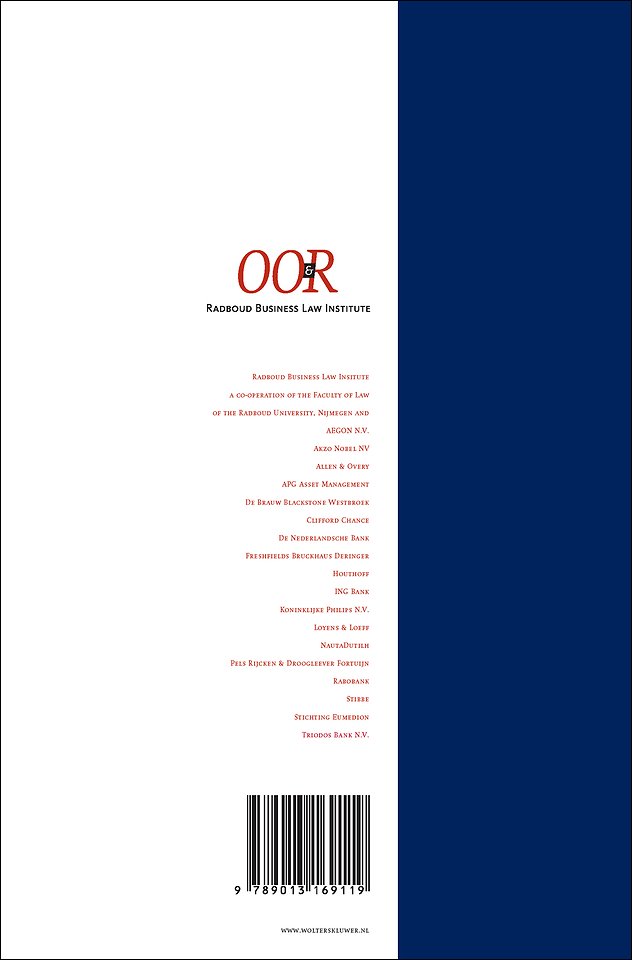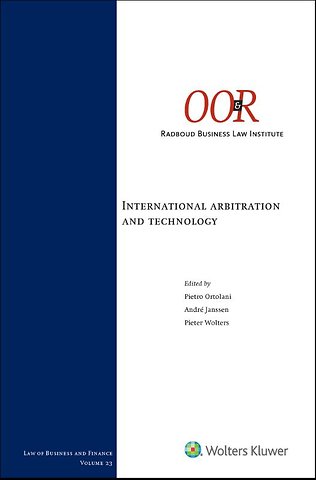International arbitration and technology
Gebonden Engels 2022 1e druk 9789013169119Samenvatting
This publication offers a practice-oriented overview of the ways in which technology affects the practice of international arbitration. The title offers the only up-to-date study of the impact of technology on arbitration, taking into account the significant change brought about by the COVID-19 pandemic.
Digitalization is increasingly impacting the practice of international arbitration. Especially in the wake of COVID-19, technological solutions are adopted by counsel, tribunals, and arbitral institutions. This trend is likely to continue in the future, thus changing the way in which international arbitration is practiced. International arbitration and technology offers the first up-to-date and comprehensive overview of the interplay between technology and international arbitration, with a specific focus on the technological developments which are currently available and already practically relevant.
Technology, arbitration and COVID-19
The publication offers an up-to-date study of the impact of technology on arbitration, taking into account the significant change brought about by the COVID-19 pandemic. In addition, the content is distinctively practice-oriented.
The authors’ practical perspectives on the impact of technology on arbitration yield valuable insights for arbitrators, tribunal secretaries, international arbitration counsel, and arbitral institutions. As many aspects of their work are already impacted by technology, they will find much value within this book’s pages. Furthermore, the book is of interest for academics working in the fields of international dispute resolution, and law and technology.
Trefwoorden
arbitrage internationaal recht digitalisering technologie online procedures virtuele hoorzittingen geschillenbeslechting covid-19 gegevensbescherming videoconferenties digitale awards elektronische communicatie data-analyse procesrecht blockchain elektronische bewijsvoering innovatie cybersecurity kunstmatige intelligentie legal tech privacy advocatuur
Trefwoorden
Specificaties
Lezersrecensies
Inhoudsopgave
U kunt van deze inhoudsopgave een PDF downloaden
Chapter 1 Introduction: international arbitration and technology 1
Pietro Ortolani, André Janssen & Pieter Wolters
1.1 Introduction: from cautiousness to experimentation 1
1.2 The reality on the ground: understanding the needs, challenges and expectation of different stakeholders 6
1.3 The role of technology in commencing and conducting arbitral proceedings 6
1.4 The digital arbitral award, its uses as data, its validity and enforceability 7
1.5 Future use-cases of technology in arbitration 8
PART I. ONLINE ARBITRATION: NEEDS, CHALLENGES AND EXPECTATIONS OF DIFFERENT STAKEHOLDERS 11
Chapter 2 Online arbitration: the perspective of the arbitrator and the secretary 13
Noam Zamir
2.1 Introduction 13
2.2 Online arbitration 15
2.3 Online arbitration from the perspective of the arbitrators 18
2.3.1 Electronic submissions 18
2.3.2 Online hearings 19
2.3.3 Online conferences 25
2.4 Online arbitration from the perspective of the tribunal secretary 26
2.5 Conclusion 29
Chapter 3 Online arbitration: the counsel perspective 31
Niek Peters & Christina Mangani
3.1 Introduction 31
3.2 The positive effects of online arbitration 32
3.3 Practicalities to be taken care of in relation to online hearings 33
3.4 Challenges for counsel during online hearings 35
3.5 Challenges with regard to the cross-examination of witnesses and experts 36
3.6 Ensuring compliance with the applicable procedural law 38
3.7 Challenges to protect confi dentiality and compliance with data protection regulations 39
3.8 Online arbitration is an opportunity 40
3.9 Online arbitration should be a “can-have” not a “must-do” 41
3.10 Concluding remarks 42
Chapter 4 Online arbitration: the institutional perspective 43
Thomas de Bekker & Camilla Perera-De Wit
4.1 Introduction 43
4.2 Regulatory and institutional framework 45
4.2.1 Introduction 45
4.2.2 Electronic communication 46
4.2.3 Virtual hearings 50
4.2.4 E-awards 54
4.3 The institution’s role in advancing online arbitration 57
4.3.1 Introduction 57
4.3.2 The institution’s role 57
4.3.3 The future of online arbitration at the NAI 60
PART II. COMMENCING AND CONDUCTING ARBITRAL PROCEEDINGS: THE ROLE OF TECHNOLOGY 63
Chapter 5 Electronic consent to arbitration 65
Luigi Cantisani & Aygun Mammadzada
5.1 Digitalisation and arbitration: a general outline 65
5.2 International legal framework applicable to electronic agreements to arbitrate 66
5.3 Technology and the role of consent in arbitration 71
5.4 Agreement contained in an exchange of communications: uncertainties surrounding electronic communications and arbitration agreements in practice 72
5.5 Electronic signatures and agreements to arbitrate: focus on the eIDAS Regulation 76
5.6 Conclusions: a look at the future 81
Chapter 6 The effects of online examination of experts and witnesses in international arbitration: familiar or uncharted territory? 83
Bas van Zelst & Bas Keizers
6.1 Introduction 83
6.2 Setting the stage: virtual hearings and fundamental notions of procedural law 85
6.3 What is on offer in other academic fi elds? 88
6.3.1 Overview 88
6.3.2 Views on videoconferencing (VC) v. face-to-face (FTF) interviews in social sciences research 89
6.3.3 Interim conclusion 92
6.4 Some remarks from the arbitral perspective 92
6.4.1 General remarks 92
6.4.2 Application to the arbitral context 94
6.5 Concluding remarks: the way forward 97
Chapter 7 Data protection and international arbitration: never the twain shall meet? 101
Emily Hay
7.1 Introduction 101
7.2 Words and principles 103
7.3 Controllers and joint controllers 104
7.4 Arbitral exceptionalism 107
7.5 Relevant legal regimes 110
7.6 Legal basis for processing 113
7.7 Notice 118
7.8 Disclosure, evidence and transparency 121
7.9 Remote hearings by video conference 127
7.10 Conclusion 131
PART III. THE DIGITAL ARBITRAL AWARD, ITS USES AS DATA, ITS VALIDITY AND ENFORCEABILITY 133
Chapter 8 Data mining, text analytics, and investor-state
arbitration 135
Wolfgang Alschner & Damien Charlotin
8.1 Introduction 135
8.2 What is legal text analytics? 136
8.3 Concepts, methods, and terminologies 139
8.4 Existing and potential uses of text analytics in ISA 143
8.4.1 Bringing a case 143
8.4.1.1 Prediction: Know the odds 143
8.4.1.2 Selection of treaties 146
8.4.2 Selecting an arbitrator: Arbitrator analytics 149
8.4.3 Litigating a case 150
8.4.3.1 Quantifying successful advocacy 150
8.4.3.2 Selecting authorities 152
8.4.4 Challenging a case: Authorship detection 155
8.5 Conclusion 157
Chapter 9 Data mining, text analytics and international
commercial arbitration 159
Piotr Wilinski & Maciej Durbas
9.1 Introduction 159
9.2 The emergence of data mining and text analytics in international commercial arbitration 160
9.3 The law stays behind – the absence of a legal framework for data mining and text analytics 161
9.4 The potential use by the parties/counsel 165
9.4.1 The use of data mining and text analytics prior to arbitration – informed decision-making 166
9.4.1.1 Selecting seat of arbitration and applicable rules; drafting arbitration clauses 166
9.4.1.2 Confl ict check 168
9.4.1.3 Assessing the case 169
9.4.2 The use of data mining and text analytics during the arbitral process 173
9.4.2.1 Selection of arbitrators 173
9.4.2.2 Controlling arbitrator’s impartiality and independence 174
9.4.2.3 Improving persuasiveness of the written submissions 175
9.4.3 Data mining and text analytics at the post-award stage 176
9.4.4 Legal implications for the use of data mining and text analytics 177
9.5 Enhancing the tribunal’s procedural toolbox 180
9.5.1 The use of data mining software by the parties 180
9.5.2 The use of data mining software at the tribunal’s initiative 181
9.5.3 Text analytics as a (self-)scrutiny tool 186
9.6 Concluding remarks 187
Chapter 10 The digital arbitral award 189
Pietro Ortolani
10.1 Introduction 189
10.2 Setting the scene: fi nding the applicable laws 193
10.3 The digital award at the seat of arbitration 195
10.3.1 Written form requirements and the digital award 195
10.3.2 Signature requirements and the digital award 199
10.3.3 Reality check: practical uses of a digital-only awardat the seat 200
10.4 The digital award outside of the seat 203
10.4.1 Is the digital award an “award” at all? 203
10.4.2 Requirement to produce the duly authenticated original award or a duly certifi ed copy thereof 205
10.4.3 Possible grounds for refusal under Article V 207
10.5 Consequences for parties, tribunals and institutions 208
10.6 Conclusion: the way forward 209
PART IV. FUTURE USE-CASES OF TECHNOLOGY IN ARBITRATION 213
Chapter 11 Technology and the processing of mass investment arbitration claims 215
Relja Radovic
11.1 Introduction 215
11.2 An outline 217
11.2.1 Defi ning mass arbitration claims 217
11.2.2 Benefi ts of IT 219
11.3 A survey 220
11.3.1 Abaclat and others v Argentina 221
11.3.2 Other cases 223
11.4 Opportunities 225
11.4.1 Procedural openness 226
11.4.2 Procedural fl exibility 229
11.5 Constraints 230
11.5.1 Due process 231
11.5.2 Arbitral mandate 233
11.5.2.1 Non-delegation of decision-making 234
11.5.2.2 Human decision-making 236
11.6 Conclusion 236
Chapter 12 Blockchain technology and arbitration 239
Pietro Ortolani
12.1 Introduction 239
12.2 The emergence of blockchain technology and private adjudication 240
12.3 Smart contracts and smart dispute resolution 242
12.4 Blockchain-based arbitration 247
12.5 Permissioned blockchain and recognition and enforcement of awards 249
12.6 Conclusion 252
Anderen die dit boek kochten, kochten ook
Rubrieken
- advisering
- algemeen management
- coaching en trainen
- communicatie en media
- economie
- financieel management
- inkoop en logistiek
- internet en social media
- it-management / ict
- juridisch
- leiderschap
- marketing
- mens en maatschappij
- non-profit
- ondernemen
- organisatiekunde
- personal finance
- personeelsmanagement
- persoonlijke effectiviteit
- projectmanagement
- psychologie
- reclame en verkoop
- strategisch management
- verandermanagement
- werk en loopbaan









